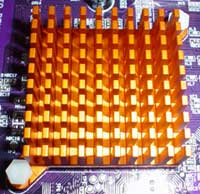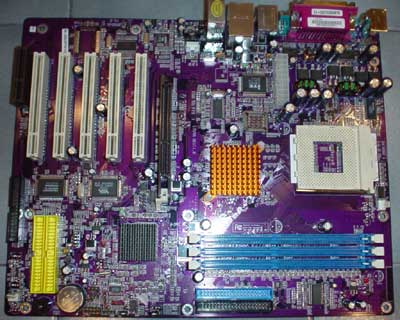ECS L7VTA (KT400): 1st with 333MHz FSB Support
by Evan Lieb on September 24, 2002 12:00 PM EST- Posted in
- Motherboards
ECS L7VTA: Basic Features
|
Motherboard Specifications |
|
|
CPU
Interface
|
Socket-462
|
|
Chipset
|
VIA
KT400 North Bridge
VIA VT8235 South Bridge |
|
Bus
Speeds
|
133
- 166MHz (in 1MHz increments)
|
|
Core
Voltages Supported
|
N/A
|
|
I/O
Voltages Supported
|
N/A
|
|
DRAM
Voltages Supported
|
N/A
|
|
Memory
Slots
|
3
184-pin DDR DIMM Slots
|
|
Expansion
Slots
|
1
AGP 8X Slot
5 PCI Slots |
|
Onboard
RAID
|
Promise
PDC20265R
|
|
Onboard
USB 2.0/IEEE-1394
|
USB2
Supported through South Bridge
VIA VT6306 Firewire |
|
Onboard
LAN
|
PCNet
HT2001 10/100
|
|
Onboard
Audio
|
VIA
VT1612A 2-channel AC'97
|
Besides supporting the fastest Socket A chipset to date (KT400) the L7VTA brings with it an onboard Promise PDC20265R RAID chip. This isn't an especially interesting RAID controller; you're capable of RAID 0 and RAID 1 arrays like most RAID chips (no 0 + 1 though) and there's support for up to ATA100 (no ATA133 here).
Moving on, ECS opted to add on VIA's 6306 IEEE-1394 (Firewire) controller as well to the L7VTA. Thankfully, ECS added a rear FireWire port for us, in addition to one IEEE-1394 header located just above the two RAID connectors. Since the VIA VT6306 IEEE-1394 controller can only support up to three Firewire ports, you're only able to add on a 2-port Firewire bracket. But this is hardly a limitation for most users; three Firewire ports are enough for us anyways.
ECS again decides to go with an onboard VIA chip for sound, dubbed the VT1612A. This is a pretty basic 2-channel AC'97 solution.
ECS went with a less common solution for onboard LAN in the form of PCNet's HT2001 0218 10/100 Ethernet chip; despite the uncommon chip, there were no issues setting up a LAN on this motherboard.
There's plenty of room for PCI and memory expansion, with 5 PCI slots and 3 DIMM slots available to the user.
 Next
up we see the interesting addition of a cooling over the VIA VT8235 South Bridge
in the form of a black-colored passive heatsink. The vast majority of motherboards
don't include South Bridge heatsinks, but clearly ECS thought it was necessary
to do so. However the heatsink was hardly even warm after hours of testing,
so we're not sure what to make of ECS's decision. Of course, there's the usual
cooling over the VIA VT8368 North Bridge, again in the form of a passive (orange-colored)
heatsink.
Next
up we see the interesting addition of a cooling over the VIA VT8235 South Bridge
in the form of a black-colored passive heatsink. The vast majority of motherboards
don't include South Bridge heatsinks, but clearly ECS thought it was necessary
to do so. However the heatsink was hardly even warm after hours of testing,
so we're not sure what to make of ECS's decision. Of course, there's the usual
cooling over the VIA VT8368 North Bridge, again in the form of a passive (orange-colored)
heatsink.
There is one interesting jumper on the L7VTA; this motherboard will support future AMD Athlon XP Thoroughbred processors running at 333MHz (DDR) FSB. AMD will be announcing support for the 333MHz FSB shortly and nForce2/KT400 will be the primary chipsets to officially support the new FSB frequency.











0 Comments
View All Comments